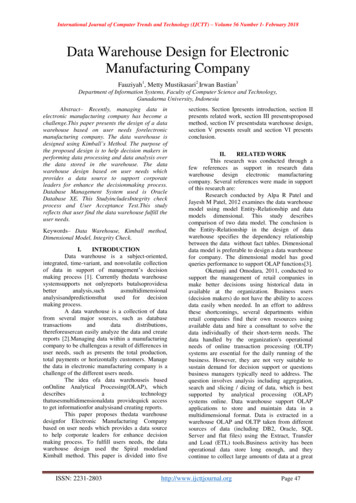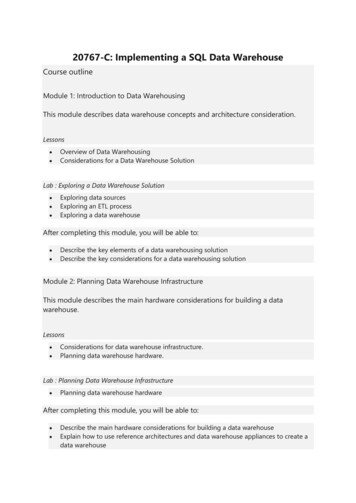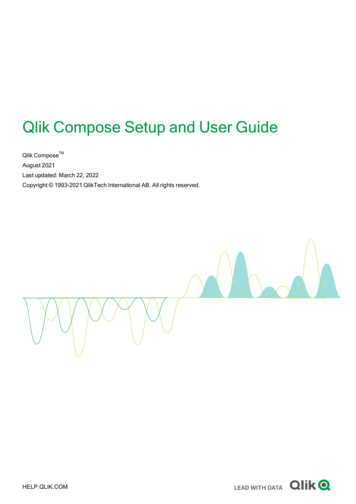
Transcription
International Journal of Computer Trends and Technology (IJCTT) – Volume 56 Number 1- February 2018Data Warehouse Design for ElectronicManufacturing CompanyFauziyah1, Metty Mustikasari2,Irwan Bastian3Department of Information Systems, Faculty of Computer Science and Technology,Gunadarma University, IndonesiaAbstract– Recently, managing data inelectronic manufacturing company has become achallenge.This paper presents the design of a datawarehouse based on user needs forelectronicmanufacturing company. The data warehouse isdesigned using Kimball’s Method. The purpose ofthe proposed design is to help decision makers inperforming data processing and data analysis overthe data stored in the warehouse. The datawarehouse design based on user needs whichprovides a data source to support corporateleaders for enhance the decisionmaking process.Database Management System used is OracleDatabase XE. This StudyincludesIntegrity checkprocess and User Acceptance Test.This studyreflects that user find the data warehouse fulfill theuser needs.Keywords– Data Warehouse, Kimball method,Dimensional Model, Integrity Check.I.INTRODUCTIONData warehouse is a subject-oriented,integrated, time-variant, and nonvolatile collectionof data in support of management’s decisionmaking process [1]. Currently thedata warehousesystemsupports not onlyreports nalanalysisandpredictionsthat used for decisionmaking process.A data warehouse is a collection of datafrom several major sources, such as usercan easily analyze the data and createreports [2].Managing data within a manufacturingcompany to be challengeas a result of differences inuser needs, such as presents the total production,total payments or horizontally customers. Managethe data in electronic manufacturing company is achallenge of the different users needs.The idea ofa data warehouseis basedonOnline Analytical Processing(OLAP), ata providequick accessto get informationfor analysisand creating reports.This paper proposes thedata warehousedesignfor Electronic Manufacturing Companybased on user needs which provides a data sourceto help corporate leaders for enhance decisionmaking process. To fulfill users needs, the datawarehouse design used the Spiral modelandKimball method. This paper is divided into fiveISSN: 2231-2803sections. Section Ipresents introduction, section IIpresents related work, section III presentsproposedmethod, section IV presentsdata warehouse design,section V presents result and section VI presentsconclusion.II.RELATED WORKThis research was conducted through afew references as support in research datawarehouse design electronic manufacturingcompany. Several references were made in supportof this research are:Research conducted by Alpa R Patel andJayesh M Patel, 2012 examines the data warehousemodel using model Entity-Relationship and datamodels dimensional. This study describescomparison of two data model. The conclusion isthe Entity-Relationship in the design of datawarehouse specifies the dependency relationshipbetween the data without fact tables. Dimensionaldata model is preferable to design a data warehousefor company. The dimensional model has goodqueries performance to support OLAP functions[3].Oketunji and Omodara, 2011, conducted tosupport the management of retail companies inmake better decisions using historical data inavailable at the organization. Business users(decision makers) do not have the ability to accessdata easily when needed. In an effort to addressthese shortcomings, several departments withinretail companies find their own resources usingavailable data and hire a consultant to solve thedata individually of their short-term needs. Thedata handled by the organization's operationalneeds of online transaction processing (OLTP)systems are essential for the daily running of thebusiness. However, they are not very suitable tosustain demand for decision support or questionsbusiness managers typically need to address. Thequestion involves analysis including aggregation,search and slicing / dicing of data, which is bestsupported by analytical processing (OLAP)systems online. Data warehouse support OLAPapplications to store and maintain data in amultidimensional format. Data is extracted in awarehouse OLAP and OLTP taken from differentsources of data (including DB2, Oracle, SQLServer and flat files) using the Extract, Transferand Load (ETL) tools.Business activity has beenoperational data store long enough, and theycontinue to collect large amounts of data at a greathttp://www.ijcttjournal.orgPage 47
International Journal of Computer Trends and Technology (IJCTT) – Volume 56 Number 1- February 2018rate as the operational database becomes morevaluable, helping to grow the rate at whichbusinesses succeed. This paper shown that the datawarehouse collect, consolidate, organize, andsummarize this structured data so that this data canbe used to inform business decisions [4].Güzin, 2007, provide decision supportsystem that has a query that is taken from theexisting student information system and canproduce reports as output to assist in decisionmaking in the University AdministrationAtilimmaster programs. The method used by Güzin is thespiral model life cycle and Kimball. Kimballmethod uses a Dimensional Modelcan be usedagainst multiple fact tables so can get varies onuser needs and also the results of research GüzinTurkmen IALA retrieval history data quickly andsave time [5].Mohammed, 2014, used a structureddatabase for a trading company that has manybranches. The author provides a method of datawarehouse that can be implemented by companieswith high accuracy, this study applies two schemesnamely star schema and snowflake schema with theconcept of a multidimensional database. Where theauthor compares the two schemes and conclude starschema has a central fact (the fact table) that can bechanged while the center (table fact) on asnowflake schema cannot be changed [6].Leonard,2011,involvingtechnicaldescription of data warehouse, design, needs, andchallenges regarding the data cleansing andconversion of existing data, as well as otherchallenges associated with transactional database.This study also includes a discussion of databaserequirements and the technology used to create andrefresh the data warehouse. This study discusseshow data from other databases and data warehouseto be integrated. In addition, there is discussion ofspecific data marts in the data warehouse to meetspecial needs. The study also covers the topic ofhow the system architecture of data from otherdatabase and data warehouse from variousdepartments can integrate. As a prototypedeveloped Enterprise Data Warehouse databaseshows how different pair of experienced Extract,Transform and Load (ETL) process and loaded intothe set is actually a star schema and then makereporting easier [7].To support the decision-making style adata warehouse can accommodate the use of dataand decision-making. Connolly and Begg(2015)stated data warehouse is integrated view ofcorporate. Disparate data is drawn from theoperational data sources and a range of end-useraccess tools capable of supporting simple to highlycomplex queries to support decision making [1].System Development Life Cycle is used inthis study is Spiral Model which consistsofrequirement gathering, requirement analysis,requirement modelling, designand evaluation.The data warehouse design with four step ofKimball’s Dimensional Lifecyclewhich be capableof supporting the information requirements ofparticular group of users. According to Kimballthere are four steps process:Select BusinessProcess, Declare Grain, Choose DimensionsandIdentify Fact [9].Integrity Constraint is a concept that aims toprevent the entry of invalid data into the base tabledatabasewhich can define boundaries to reinforcethe business rules to associate the information onthe database [1]. According to Connolly and Begg,Integrity Constraint consists of NULL, traint.IV.DATA WAREHOUSEDESIGNA. Kimball’s MethodThe fourth section designed datawarehouse used a four steps process of Kimball’sMethod, with details of the process as follows:First step is select business processes. Ascanbe seen in Fig. 1, business processes start from theprocurement staff made an order to purchasematerial to the supplier. After ordering, supplierwill send material to the company that will receiveby the warehouse. In the warehouse the materialchecked by staff. If the material defects, it will berefund to supplier in return material process, whilematerials passed from checked will be sent forassembly into products. After the production thegoods delivered to warehouse before delivered tocustomers. If any goods are defective, it will returnin return goods process. Payment for materials andgoods by finance company.III.PROPOSED METHODAccording toSauter(2010), the formation, qualityinformation, and the amount ofchoiceandsuitabilityofmodeling.Thegooddecisionis obtaininformation that hhasthepurposeamong others: Completingthe sistancetodecisionnonstructuralandmanaging knowledgethatexist in the company [8].ISSN: 2231-2803http://www.ijcttjournal.orgPage 48
International Journal of Computer Trends and Technology (IJCTT) – Volume 56 Number 1- February 2018Fig 1:Business Process OfElectronicsManufacturingCompanyThe user needs related to the process thathas been described previouslydisplayed in themodel Entity Relationship in Fig. 2. Where darkentities representing the fact of the electronicsmanufacturing company.Second step is declare grain. The grain in anattribute that fill in the fact tables. Identifies thegrain for this study, namely:total material, sub totalmaterial, total return material, total pay material,total production, total material production, totalgoods, sub total goods, total return goods and totalpay goods.Fig 2 : Business Process Model Of Electronics Manufacturing CompanyThe third step is choose dimensions.Dimensions set context is needed later in the facttable. The dimensions identified namely:material,request material, supplier, goods, request goods,customer and production.The last step isidentify facts. Grain from thefact table determine the facts that can be used in thedimensional model. The list of the fact tablesarepurchase material table, returnsmaterial table,paymentmaterial table, production goods table,material production table, purchase goods table,returns itemstable and payment items table.B. Entity Relationship ModelEntity-Relationship model design for datawarehouse manufacturing company can be seen inFig. 3. The design of model Entity-Relationshipconsists of 7 entities that are interconnected.Entity Relationshipmodel design in figure 3consists of 7 entities: request material entity,material returns entity, payments material entity,request goods entity, returns goods entity,payments goods entity and production entity.C. Dimensional ModelDimensional models in the design of ElectronicManufacturing Data Warehouse use Star Schemabased Kimball Dimensional Lifecycle. Thestarschema can be seen in Fig. 4.ISSN: 2231-2803http://www.ijcttjournal.orgPage 49
International Journal of Computer Trends and Technology (IJCTT) – Volume 56 Number 1- February 2018Fig 3: Entity-Relationship Data Warehouse Design Electronics Manufacturing CompanyFig 4 : Dimensional Model Data Warehouse Design Manufacturing CompanyV. RESULTA. Prototype Data WarehouseThe data warehouse design is implementedusing Oracle Database XE. The design based on thefact tables and dimension tables. This prototype hasbeen equipped with Integrity Constraint on eachtable. For Integrity Constrain affixed to the table’sdata warehouse.ISSN: 2231-2803Prototype Data Warehouse consists of 15tables : material table, request material table,purchase material table, return material table,material payment table, supplier table, goods table,purchase goods table, customer tables, requestgoods table, return goods table, payment goodstable, production table, production goods table andmaterial production table.http://www.ijcttjournal.orgPage 50
International Journal of Computer Trends and Technology (IJCTT) – Volume 56 Number 1- February 2018B.ReportThe design report serves as the reportingdata that has been stored and processed in the datawarehouse. In designing data warehouse isproduced 11 reports, namely:purchase materialreport, returns material report, material paymentreport, purchase goods report, return goods report, sub total purchase material report,sub total sales of goodsreports, goods productionreport and material production report.Designing reports displayed on Excel tofacilitate programmers in creating a report later.For example in the design data report purchasesmaterial made with the following query:select"BOOKMT"."CD MTREQ"as"REQUEST MATERIAL CODE","BOOKMT"."CD SUPPLIER"as"SUPPLIER CODE","SUPPLIER"."NM SUPPLIER"as"SUPPLIER","REQMT"."REQDATE" as "REQUESTDATE","MATERIAL"."NM MATERIAL"as"MATERIAL","BOOKMT"."TOTAL ITEM"as"TOTAL MATERIAL","BOOKMT"."AMOUNT ITEM"as"TOTAL AMOUNT","BOOKMT"."NOTE" as "NOTE"from"SUPPLIER" "SUPPLIER","BOOKMT" "BOOKMT","REQMT" "REQMT","MATERIAL" "MATERIAL"where"BOOKMT"."CD MTREQ" "REQMT"."CD MTREQ"and"BOOKMT"."CD SUPPLIER" "SUPPLIER"."CDSUPPLIER"and"REQMT"."CD MATERIAL" "MATERIAL"."CD MATERIAL"order by BOOKMT.CD MTREQ ASCIn this report, there are eight data displayed:Request Material Code, Supplier Code, SupplierName, Request Date, Material Name, MaterialTotal, Total Amount and Note. When observed,there is a blue color under the name of the column.The blue color is to indicate source of data, in orderto facilitate the programmer put it on the actualreport.The display example of a draft reportsasfollows:ISSN: 2231-2803Fig 5: Purchase Material ReportAnother design report regarding to returnmaterial, the data created with the following query:select"RETURNMT"."CD MTREQ"as"REQUEST MATERIAL CODE","SUPPLIER"."NM SUPPLIER"as"SUPPLIER","MATERIAL"."NM MATERIAL"as"MATERIAL","RETURNMT"."RETURN DATE"as"RETURN DATE","RETURNMT"."TOTAL RETURN" as"TOTAL RETURN","RETURNMT"."REASON"as"REASON"from"REQMT" "REQMT","SUPPLIER" "SUPPLIER","RETURNMT" "RETURNMT","MATERIAL" "MATERIAL"where"REQMT"."CD MATERIAL" "MATERIAL"."CD MATERIAL"and"RETURNMT"."CD MTREQ" "REQMT"."CDMTREQ"and"RETURNMT"."CD SUPPLIER" "SUPPLIER"."CD SUPPLIER"order by RETURNMT.RETURN DATE ASCThere are six data displayed: RequestMaterial Code, Supplier Name, Material Name,Return Date, Total Return and Reason. The bluecolor under column name indicate source of data.http://www.ijcttjournal.orgPage 51
International Journal of Computer Trends and Technology (IJCTT) – Volume 56 Number 1- February 2018checking primary key, foreign key checks, checksnot null, unique constraint checking and checkingof the check constraint.D. Evaluation ResultThis study using User Acceptance Test toevaluate the performance of the database. TheDatabase is evaluated by 15 users. Users fill out aquestioner consisting of 10 statement that can beseen in Table 2.TABLE 2QUESTIONER STATEMENTQ1Fig 6 :Return material reportC. Integrity CheckThisstudyappliedanintegritycheckprocess. The checking based on the Integrityconstraint of the data warehouse through buildingprototypes. In this study there are eight processesinvolved, namely: material purchase, returnmaterial, material payment, purchase goods, returngoods, payment goods, production goods andmaterial production. Integrity Check processof thedata warehouse can be seen in Table 1.SchemaMaterial ProductionPayment GoodsPayment MaterialProduction GoodsPurchase GoodsPurchase MaterialReturn GoodsReturn MaterialTotalTablesColumP r nsimaFo ry Kreig eysNo n Kt N eysUn ullsiquCh eseckTotalConstraintTABLE 1INTEGRITY CHECK IN DATA WAREHOUSEMANUFACTURING 10105711111126 122242460635323524414129316 268111111Integrity Constraint checks carried out bytrying to enter the data that is contrary to theIntegrity Constraint applied to each process.Update the data in the data which has a relationshipand finally perform deletion on data that haverelationships. This check is merely checking theinput, update and delete data manually throughprototype data warehouse that has been made.Constraint checks carried out on the datawarehouse manufacturing companies, namely:ISSN: 2231-2803Data which is attached to the design of theData Warehouse Electronics ManufacturingCompany has full accordance with userneeds.Q2Designing the Data Warehouse ElectronicsManufacturing Company can demonstratethe amount of material and the amount ofgoods.Q3Designing the Data Warehouse ElectronicManufacturing company can show thenumber of returns of material and return ofgoods.Q4Designing the Data Warehouse ElectronicsManufacturing Company can demonstratethe amount of material ordering andordering goods.Q5Designing the Data Warehouse ElectronicsManufacturing Company can demonstratematerial payments and payment of goods.Q6Designing the Data Warehouse ElectronicsManufacturing Company can demonstratematerial payments and payment of goods.Q7 Designing the Data Warehouse ElectronicsManufacturing Company can indicate theamount of production of goods.Q8Testing duplicate data through IntegrityConstraint on the customer and supplier arein accordance with the needs of users wherethere are no similar data.Q9Integrity Constraint function accordancewith user needs.Q10 Dimensions contained in the DataWarehousedesignElectronicsManufacturing Company are in accordancewith user needs such as Material, Item,Customer, Supplier, and Returns.The result is performed by compute thepercentages of number of users who choosestrongly agree, agree, neutral, disagree and stronglydisagree. The percentage of each assessment can beseen as follows:http://www.ijcttjournal.orgPage 52
International Journal of Computer Trends and Technology (IJCTT) – Volume 56 Number 1- February 2018This paper obtained 7 dimension tables and8 fact tables and 11 draft reports that serves as areport of the data stored and processed in the datawarehouse. This study was completed by gettingthe user evaluation.55,33% ofuser statedagree ofthe statement, 23,33% of user statedstrongly agreeof the statement and 21,33% of user neutral.Therefore it can be said that user in this companyare satisfied withthe data warehouse design becausethe database matched the user needs.Overall the result of the questioner can beseen in Table 3.TABLE 3QUESTIONER ormation :SA: Strongly AgreeA: AgreeN: NeutralD: DisagreeSD: Strongly DisagreeVI.CONCLUSIONSThe Data Warehousedesign for ElectronicManufacturing Company is presented in thispaper.The Data warehouse is designed using spiralapproachand Kimball method. The design isimplemented using Oracle Database XE. ThisStudy includes Integrity check process and UserAcceptance Test. The performance result showsthat the data warehouse is match the userneedseventually helps them in discovering criticalpatterns and trends. However, there is still moreresearch needed to improve the performanceresult.For the next research thedatabase designshould be added by a wider scope of processes suchas include a journal for each transaction. Inaddition, the future study should also add an ETLprocess.REFERENCES[1][2][3][4]The statement shown in bar chart can beseen in Figure 7. Orange color indicates usersstrongly agree, yellow colorindicates users agree,green colorindicates a neutral, red colorindicatesusers not agree and brown color indicates the usersstrongly disagree.[5][6][7][8][9]Connolly, T, M., and Begg C. E, Database Systems: APracticalApproach to Design, Implementation andManagement, 6th Edition, Pearson Education, 2015.IBM Corporation, Database Fundamental, IBM Canada,Canada,2010.Patel, Alpa R., Patel, Jayesh M, “Data ModelingTechniques for Data Warehouse”, International Journal ofMultidisciplinary Research, Vol. 2, Issue 2, February2012.Oketunji, Temitope A., Omodara, Raufu O, “Design ofData Warehouse and Business Intelligence System: ACase Study of a Retail Industry”, thesis, School ofComputing Blekinge Institute of Technology, Sweden,2011.Türkmen, Güzin, “Developing a Data Warehouse for aUniversity Decision Support System”. A Master’s Thesis.Turkey, 2007.Mohammed, Khalid Ibrahim, “Data Warehouse Designand Implementation Based on Quality Requirement”.International Journal of Advances in Engineering &Technology, July. 2014.Leonard, Edward M. (2011) Design and Implementation ofan Enterprise Data Warehouse. Paper 119. s open/119.Sauter, Vicki L, “Decision Support Systems for BusinessIntelligence”, John Wiley & Sons, Inc. Canada, 2010.Kimball, Ralph., Ross, Margy, “The Data Warehouse ToolKit”, John Wiley & Sons, Inc, Canada, 2013.Fig 7:User Evaluation ResultISSN: 2231-2803http://www.ijcttjournal.orgPage 53
A. Prototype Data Warehouse The data warehouse design is implemented using Oracle Database XE. The design based on the fact tables and dimension tables. This prototype has been equipped with Integrity Constraint on each table. For Integrity Constrain affixed to the table's data warehouse. Prototype Data Warehouse consists of 15










